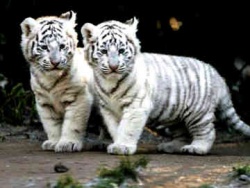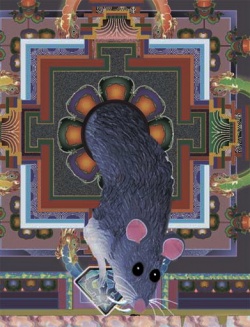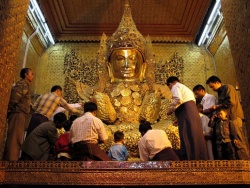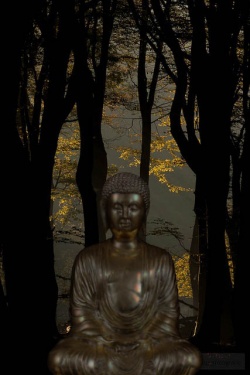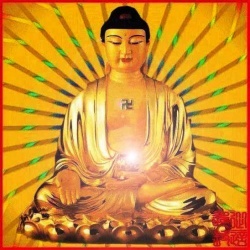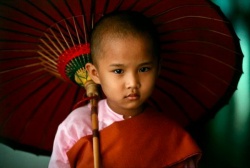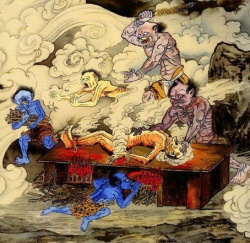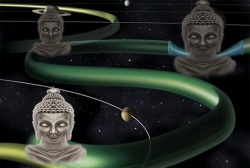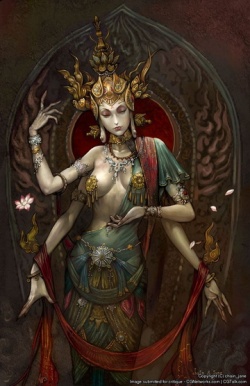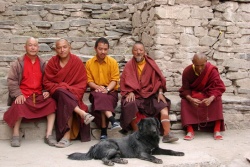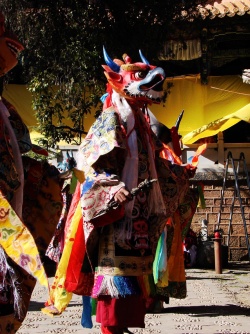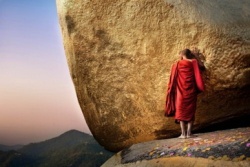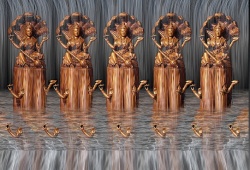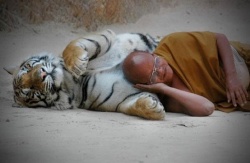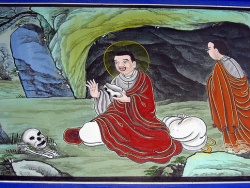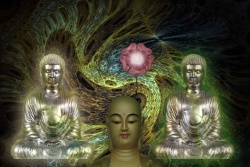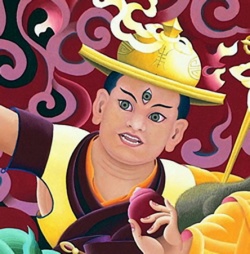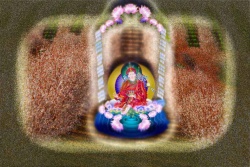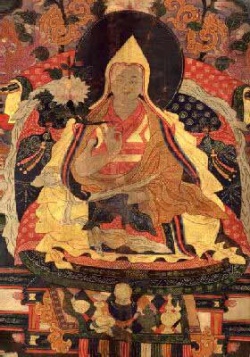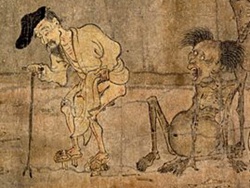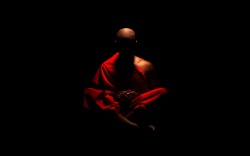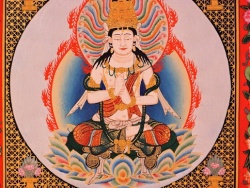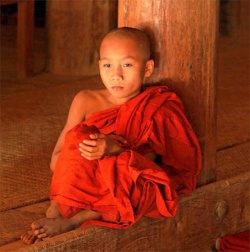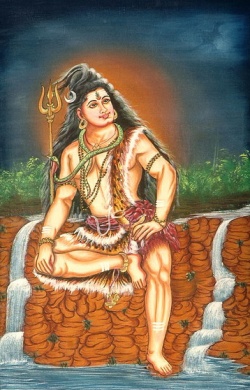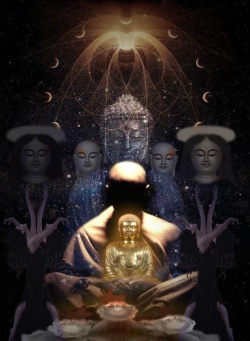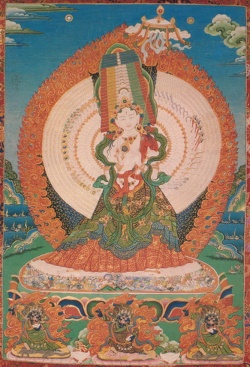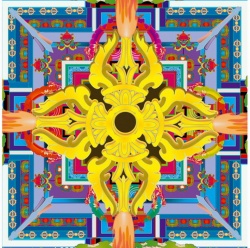The Tiger
Indian Mythology
The tiger is the vehicle of, and sacred to, the Hindu goddess, Durga. From a certain perspective she is India's Mother Nature, for she is the deification of Energy. Her consort, Shiva, sometimes evoked as Shambo, wears a tiger skin to indicate that he is beyond the bounds of the natural world.
He came by this vestment in a myth that recounts how the consorts of forest-dwelling sages were so taken with his physical beauty as he wandered naked through the jungle that they considered abandoning their husbands.
The men felt they had to eliminate him at whatever cost, so they dug a great pit into which they conjured, by means of mantric magic, a great and ferocious tiger.
The Great God easily slew the beast making of its skin a loincloth.
In his most ancient form, Lord Shiva was known as Rudra, the Howler, and the Yajur Veda describes him as clothed in a tiger skin.
Thus a tiger pelt was once the typical mat (Skt. asana) of the meditating yogin up until the mid-20th century.
Now we are more conscientious and would never contribute to the rapid disappearance from the world of this impressive solitary animal.
Instead of an actual tiger skin, today a rug depicting the animal is sometimes used as a seat/mat for doing tantric practices. These are available in 3 main designs from various Tibetan and Nepali companies.
One is a stylized pelt, another has a "happy tiger" motif -- the animal or a pair in the a forest; the third kind is just an abstract striped field.
==Tiger as Protector==
The tiger is one of four animals associated with the Kagyu lineages of Tibetan Buddhism. Bodhisattva Vajrapani wears the skin of a tiger and sworn dharma protectors such as Mahakala follow in this tradition that combines yogic symbolism with the Buddhist association of the tiger to compassion and generosity.
From a material perspective the bodhisattva vow (to forego one's own enlightenment until others can also achieve it) can be expressed by the donation of the body for the purposes of furthering the Buddha's Dharma.
In legend, literature and art, there appears a motif in which someone makes a gift of his/her body to an animal, often a tiger, that evokes the Buddha's gift of Dharma.
This can be underlined by having the "same" individual -- either an ascetic or a wayward monk -- receive both gifts.
Although the parallel is not explicit, Reiko Ohnuma ("The Gift of the Body and the Gift of Dharma," History of Religions, 37:4 (1998) 323-59) demonstrates there is an implicit identification between the Buddha's gift and the offering of the body.
The Mahamudra Chod [pron.: cheu is a practice that uses this offering in a powerful way.
==Karmic Connections==
Khenpo Karthar, in Dharma Paths (Snow Lion, 1992/2006):
It was not possible to hear the teaching of the Buddha without having a past karmic connection with him.
Accordingly, when the Buddha gave the teaching on the four noble truths, in the assembly receiving the teachings were five human beings and 80,000 beings of the god realm.
If we go back to the previous lives of the Buddha, we can explain the karmic connections these beings had with him. In one of his previous lives, the Buddha was born as the youngest of three princes.
When he was only five years old, the three princes were in a forest playing together at hide-and-seek and other games.
As they were walking in the forest, they came to a cave where they saw a wounded female tiger with five cubs.
The mother tiger was very weak and was unable to provide food for the baby tigers. The Buddha's older brothers went to search for some food, and they asked the young prince to stay near the cave to take care of the mother tiger and the five cubs.
While the Buddha was taking care of the wounded tiger and her five cubs, he began to think that it was not proper to kill other beings and give their flesh to the tiger.
He found some large thorns and pressed them into neck, and as the blood came out, he let the cubs and their mother suck the blood.
In fact, he gave his whole body to the five cubs and their mother as an act of generosity.
As he did this, the Buddha prayed, "Right now I am only able to give temporary help to these starving beings, just removing their hunger.
May these tigers who are enjoying my flesh, blood, and bones be reborn to a higher realm, and may I be able to teach them and lead them out of cyclic existence."
As a result of this karmic connection, the five cubs were reborn in the human realm where they attended that first teaching of the Buddha in the form of his first and only human students.
They attained the level of arhat. (The others were 80,000 inhabitants of the god realm and they became first-level bodhisattvas.)
Generosity
The second tale in the Tibetan collection The Sutra of the Wise and the Foolish (mdo mdzangs blun) tells how the Buddha, at the behest of a distraught mother, saves two young thieves from execution by accepting them into the monastic community.
When Ananda expresses amazement, Buddha replies, "Not only have I benefited these three, the mother and her sons, at this time alone; I also benefited them at a previous time as well."
He tells how the prince Mahasattva encountered a tigress so weak with starvation that she is contemplating devouring her newly born cubs.
The man slits his throat with a piece of wood and lets her drink his blood. Finally, he lets her devour him completely which saves the lives of all of the tigers.
Following the usual Jataka pattern, at the end of the story, the Buddha reveals that he himself was that prince while the two youths he had just saved from execution were none other than the two tiger cubs -- the mother, of course, was the starving tigress.
"Formerly," he concludes, "a long time ago, I freed them from difficulty, saved their lives, and made them happy.
And now, having attained complete Buddhahood, I have again freed them from difficulty and completely liberated them from the great suffering of samsara."
Namo Buddha is the name of the site in Nepal, where legend says the Buddha performed this supremely compassionate act of generosity.
It is known to Tibetans as Tag-mo Lu-jin.
Bhadra of the Buddhist scriptures was a cousin of the Buddha and one of his great disciples. He is described as a good preacher able to explain the dharma in clear, simple language.
Often depicted holding a book, he is also the arhat in images of the 16 who is accompanied by a tiger which he soothes or restrains.
Samantabhadra [All-good Buddha)] is also associated with the tiger.
Dharmata, the upasaka (Tib: gen nyen dhar ma ta) or Dharmatala is one of the attendants often appearing in images of the 16 arhats. He is usually shown seated, often in a chair, in the company of a tiger.
Other Tibetan Buddhist Deities
Vyaghramukha or, Tiger-Faced Dakini, appears in the entourage of Lion-face Dakini. See vyaghra, below.
The Blacksmith, avowed protector of the Nyingmapa, Damchen Garwa'i Nagpo, holds a hammer in his right, and outstretched in his left hand, a tigerskin bellows for his fire.
One of the 5 Long-life Sisters converted by Padmasambhava is Mikyo Losangma (Immovable Noble Mind) whose mount is a large young tiger. She is yellow and offers food with her right hand and a full golden bowl with her left.
==Tiger-rider==
The Dombi Heruka, one of the 84 great tantric masters (a.k.a. Dompipa) had been a king of Maghada (9th century Bengal) when he decided to take up tantrism full-time, particularly the practice of Hevajra. He took a tribal or gypsy girl as his consort and vanished into the jungle with her for 12 years.
Rumors of his scandalous life sent his former ministers after him, but when they saw the consort walking on lotus pads, they were discouraged from approaching. A further 12 years later, people went to fetch him again, and this time the embracing couple emerged from the forest waving a snake as a whip seated on a pregnant tigress.
The end of the legend is found in #4 at Keith Dowman's site about the new edition of Masters of Enlightenment.
A similar story is told of Padmasambhava, according to A. M. Butters (The Ancient History of Taktsang):
Manifesting as the wrathful Dorje Drolö, in year 747 of the Common Era, Padmasambhava (also known as Guru Rinpoche, revered throughout the Himalayas as "the second Buddha") came from Tibet to Bhutan on the back of a flying tigress (believed to have been his consort's magical form.)
In the west of the country, in the north of Paro Valley, in a cave on the face of a 4000 ft. cliff, he stayed and meditated in order to subjugate demonic forces that were oppressing the country and even threatening the life of the king. This place was called Taktsang.
Taktsang, which is above Paro in Bhutan, is only one of 13 tiger's nests (Tib. sTag-tshang) or sites where Guru Rinpoche is believed to have revealed tantric teachings; here most notably, the cycle of Vajrakila (indestructible dagger.)
Senasepa riding his tiger. The tiger is a particularly apt symbol for wisdom and for the symbol for Vajrayana itself -- it can get you there, but could also eat you along the way.
From the 9th to the 12th centuries ,the Cholas were a powerful dynasty that ruled over half of India, from Thanjavur in Tamil Nadu South India.
Their empire also extended south to Sri Lanka and as far east as Indonesia.
The Sri Lankan Tamil separatists call themselves Liberation Tigers of Tamil Elam (LTTE) not only after the animal's reputation for ferocity and fearlessness, but in their identification with the Cholas, whose dynastic emblem was the tiger.
China promotes several places as the Shangri-la of Hilton's political novel, Lost Horizon.
One of the candidates is Zhongdian in northwest Yunnan.
Getting there requires a 5-hour bus ride from Lijiang that climbs through the Hengduan mountains and cuts across a great river system that rushes down from the Tibetan plateau.
It winds through dramatic forests and isolated villages, at one point passing a place where the banks of the Yangtze narrow.
This legendary spot is called Tiger Leaping Gorge after an animal that successfully managed to escape its pursuers by leaping across the river.
==Chinese Tiger Symbolism==
In Chinese iconography, tigers are used to stand for the cardinal directions:
==Tiger forms==
White Tiger represents the earth, the West and so, the afterlife.
Blue Tiger represents the East, fertility and vegetation.
Red Tiger represents the South and fire.
Black Tiger represents the North and winter.
Yellow Tiger represents the sun at the centre.
Among the Chinese 12 symbols of sovereignty, there is a pair of bronze sacrificial cups. They stand for filial piety towards father and mother; one features a tiger to symbolize strength and the other, a monkey for cleverness.
Among the 12 animals of the Chinese calendar, the tiger is not only noted for strength but also for courage and perseverance.
==Tiger forms==
Tiger forms in gung fu include black tiger, winter tiger, Imperial [scroll down, look left.]
Chinese deities riding tigers include Chang Tao-ling, the Taoist Immortal who is also the god of wealth and hence, of gamblers. The goddess of the wind also has a tiger as her mount. The constellation Westerners know as Orion is seen as only part of the constellation known to Chinese as the White Tiger.
==Miao Shan==
Miao-shan, the daughter of a Chinese ruler, rose to heaven on a tiger at the time of her martyrdom. She was reborn as Kwan-yin, so they say. Is it this smiling tiger that is believed to care for the welfare of children and so, is embroidered on children's clothing? Her story is told in Alice Getty's The Gods of Northern Buddhism:
In the eleventh year of the Epoch of the Heaven of Gold, 2587 B.C.[E.], there lived a king called Miao Tohoang. He had three daughters and no sons, so when they were old enough to marry he found them suitable husbands that he might have an heir to the throne.
But Miao-shan, the youngest, refused to marry, saying that she preferred to pass her life in seclusion in order to perfect herself in meditation, and thus arrive at the state of Buddhahood.
She retired to the monastery of the White Sparrows in order to live in perfect seclusion. The king attempted to persuade her to return, but every kindly overture failed. He then resorted to cruelty, each trial being more horrible than the last, but she came out unscathed from them all. {In one incident, he is said to have set fire to the convent.
Then he ordered her beheaded. But during the execution there sprung up suddenly a great wind storm, the heavens were obscured, and a great light surrounded Miao-shan.
Then the local protective deity took the form of a tiger, bounded out of the forest, and carried her inanimate form into the mountains.
She then found herself in hell, visiting Yama, the lord of Hell, and by her magic power she liberated the souls damned there.
Upon her return, Buddha appeared to her on a cloud. He counseled her to retire to the island of P'u-t'o some three thousand miles away, and to give herself up to meditation.
Some versions of the story say she was again carried away by a deity in the form of a tiger, while others say she was carried over the water on a lotus.
For nine years she remained on the island practicing meditation and performing acts of merit, after which she was raised to the rank of Buddha and took her first acolyte, Hoan Shen-ts'ai (he who prays in order that he may have virtue and talent).
Later, she acquired another acolyte. The third son of a Dragon King of the Sea was wandering upon the waves one day in the form of a fish. All at once he found himself entangled in a fisherman's net and then offered for sale in the market.
Miao-shan, whose eyes see all things, discovered the danger and sent Shen-ts'ai in human form to buy the fish and set it free. The Dragon King was much touched by her kindness, and sent her, by his granddaughter Lung-nü, a pearl that gave light in the dark, so that she might read the sutras at night.
Lung-nü was so entranced with Miao-shan that she conceived the idea of herself acquiring Buddhahood, and asked to remain with her as her second acolyte, to which Miao-shan readily consented. Miao-shan later converted her parents to Buddhism and became a "Savior of humankind," able to remove all obstacles to their attaining Amitabha's paradise.
She herself, however, refused to enter it as long as any human being was excluded.
==Judgment by Tiger==
In Thailand not so long ago, when several people were suspected of the same serious offense, they were all thrown into a tiger pit. The first one killed by the tiger was considered the guilty party.
==In Japan==
In Japan, the tiger is said to live a thousand years and was one of the emblems of the samurai, perhaps because of the story which follows:
A gosho of the Nichiren tradition
In a letter to a samurai patron in 1278, Daishonin gave this example of the power of confidence in the Teachings:
"The mother of the mighty warrior General Li Kuang was devoured by a ferocious tiger. He spied the beast and shot it with an arrow, but then discovered that what he had seen was only a rock. The arrow lodged itself deep in the rock. He was surprised and tried to duplicate his feat but could not penetrate the stone a second time. Later he came to be known as General Stone Tiger. "
18th century Japanese tiger painting: cf. real vs. imaginary animal.
==Mysterious Tiger==
In Malaysia and Indonesia, there are also tales about were-tigers, perhaps because the actual Sumatran tiger -- now almost extinct -- is so mysterious. However, tales are also told of the friendly tiger.
The Skin of the Tiger King a Mongolian were-tiger tale.
The Bluebeard motif appears in the Indian tale of a Brahmin girl who married a tiger.
Mythologist Joseph Campbell: " If you're raised as a tiger, do you have to live like one?"
Other Folklore
The Tibetan version of the race between un-equals is told of a tiger and a frog.
Vietnamese tale about a boy and the tiger's child.
Biology, Ecology and Natural History
Panthera tigris is the largest of all the cats. It reaches lengths of 13 ft. (4 m) - tail included, and can weigh 650 lb (290 kg), much larger than any lion. According to Project Tiger, there used to be 8 varieties of tiger; four have "gone extinct" -- one just recently -- in 2000, there were five.
The eight tiger subspecies that once were: The heavily furred Siberian or Amurtiger, the South China tiger, the Indo-Chinese tiger, the broad-faced Sumatran and the Royal Bengal. Differences relate to size, habitat and range.
Albinos tigers are well-known, especially since they have been bred in cpativity. They have also been bred with lions due to genetic similarities.
However, unlike the lion, they are solitary and perhaps it is this characteristic that makes of the tiger a symbol of chastity.
Unlike their cousin the lion, they enjoy bathing in water and generally hunt at night.
The wide range of a male permits it access to a few females who give birth to two or three cubs for which they care for two years.
In 2000, there were estimated to be only about 5,000-7,000 wild tigers left in Asia. Found in a variety of habitats, even in Himalayan valleys at a height of 3,000 meters, tiger require sufficient vegetation for camouflage, ready access to water and a population of ungulates to serve as prey.
In 2003 in Nepal, according to Nepal News, the Bengals found there preyed primarily on deer and wild cattle. Although they are the strongest of the cat species, an old or "renegade" animal will occasionally take domestic cattle or become a man-eater.
A tiger chudders when it encounters its den mates. Your domestic cats can be encouraged to imitate that greeting, if you make a high gurgling as you meet them.
Details of tigers' paws 'n claws.
The Sundarbans: the mangrove swamp preserve in Bengal, where "Tigers have been known to swim out to larger boats and leap aboard. People on board may begin to call out, "Ma," –- or mother, a word meant to hail the goddess, Bonobibi. Legend has it that the echoes of someone’s screams at facing a tiger are eaten by the tiger. No one hears the scream as the tiger takes its prey."
Documentary "Broken Tail's Last Journey," shown Oct. 2009 on The Nature of Things with David Suzuki (CBC tv) states there are fewer than 1,400 tigers left in India.
Dec. 18/05, London's Sunday Telegraph, "Survey raises fears India's Bengal tigers may be wiped out in 10 years":
A new survey of India's tiger population has established there are many fewer of the animals than previously believed, prompting fears that increased poaching could lead to their extinction within a decade.
The Wildlife Trust of India has revealed there are few or no tigers left in at least six of the country's main reserves. According to official statistics, Namdapha in the northeastern state of Arunachal Pradesh had 61 tigers in 2002, but the trust assesses that there is only one animal left now.
In Buxa in West Bengal, where 32 Indian tigers, also known as Royal Bengal tigers, were reported in 1997, none is thought to remain.
The disturbing new figures come a month before a planned national survey of tigers in India. "This is an extremely worrying development," said Ashok Kumar of the Wildlife Trust of India. "We're afraid that the poachers will now move on to the other, better-known reserves where tigers are still doing well."
Unless the current rate of decline is reversed, the country's tiger population, 3,500 officially but perhaps as low as 1,500, could be wiped out by 2015.
"There's very little chance of saving the tiger now," said Belinda Wright, the British director of the Wildlife Protection Society of India. "It's got to the stage where it's beyond a crisis and the Indian government is in complete denial about what's going on. We've lost the battle."
The current wave of poaching is being driven by the escalating demand for tiger skins in Tibet. The skins are much sought-after as fashionable additions to traditional garments worn to weddings, horse festivals and at New Year.
The Wildlife Trust of India is pressing for the establishment of a wildlife crime bureau and for the government to hold talks about the illegal trade with the Chinese authorities.
"It's a huge criminal racket," said Kumar. "A villager can earn as much in one night from poisoning and skinning a tiger as he could earn from farming in five years. Eventually, that skin can sell for up to $6,000 US in Lhasa."
Other reserves from which tigers have disappeared include Dampha in the eastern state of Mizoram, Sariska in the western state of Rajasthan and in Indravati in the central state of Chhattisgarh.
"There's only one lonely tigress left in Palamau," said Kumar, referring to the reserve in the central state of Jharkhand. "It's very sad. She can be heard calling out for a mate, but there's no response."
Conservationists are particularly critical of the failure of India's wildlife authorities to bolster its forestry service. There has been little or no recruitment of forestry staff in more than 20 years and no training in a decade. The aging guards are no longer equipped to deter highly motivated, well-organized bands of armed poachers.
The majority of tigers living outside the reserves, up to half of the total tiger population, have already been destroyed.
Death Comes to the King
There will soon be no more tigers.
One reason is the fact that, in Chinese mythology, the tiger is the King of Beasts.
". . . all Tigers bear the Chinese character for king in the stripes on their brow. This looks like an "H" turned on its side with an extra line through the middle. . . . . they imbue the Tiger with all sorts of fantastical magical powers, particularly in the realm of Traditional Chinese Medicine (TCM).
Tiger parts are said to cure everything from toothaches to hemorrhoids. Many Kung Fu liniments, such as Dit Da Jow, used tiger bone in their original recipes. While some short-sighted people rigidly adhere to such "traditional" recipes, modern healers agree that this is preposterous.
One of the intrinsic beauties of TCM is the it is highly flexible and adaptable. There are plenty of herbal alternatives to the use of endangered species, and respectable healers use these cures and honor the law. [[[Martial arts]] actor Jackie Chan heads a campaign] by the Global Survival Network (GSN)."
~ Gene Ching, martial arts instructor
However, we can no longer blame solely the Chinese for the dwindling tiger population.
Sept. 24. 2005, The Telegraph, "Tibetan trimmings ring tiger knell: Fashion stokes demand for skin:
The Indian tiger is heading rapidly towards extinction, thanks to a new breed of wealthy Tibetans who prize the skins as trimming for their traditional costumes, an investigation has shown.
Until recently it was tiger bone used in Chinese medicine that was thought to be driving the escalating poaching trade, but it is now clear that Tibetan fashions are stoking demand to unparalleled and unsustainable levels.
This year alarm bells sounded in India when it emerged that one of the country's most prestigious reserves, Sariska in Rajasthan, had been completely emptied of tigers by poachers.
Hearing rumours that the new Tibetan trend for skins was behind the rapid increase in poaching, a team from the London-based Environmental Investigation Agency went to Tibet and the Sichuan and Gansu provinces in China.
What they found surpassed even their worst nightmares.
In New Delhi on Thursday, Belinda Wright, of the Wildlife Protection Society of India, who was part of the undercover team, said the time for scaremongering was over.
"This is it. The end is now in sight for the Indian tiger. The sheer quantities of skins for sale are beyond belief. As the Sariska scandal so clearly showed, the Indian tiger is now being systematically wiped out."
At horse festivals in Tibet and Sichuan, dancers, riders and spectators wandered about, openly wearing the traditional chuba, generously trimmed with tiger and leopard skin, while organizers and local officials joined in.
Traders said the demand for the skins was coming from the newly-moneyed classes who had made small fortunes from selling a local caterpillar fungus used in Chinese medicine.
Demand for the fungus has rocketed since two Chinese Olympic athletes attributed their success to its stamina-building powers. A rare mushroom is also fetching high prices.
The skins are smuggled along well-established Nepali trading routes into Tibet where they are sold openly in shops in capital Lhasa. Using hidden cameras, Wright, who has devoted 35 years to saving the Indian tiger, toured the centre of old Lhasa posing as a buyer.
She said: "In 10 shops, we found 24 tiger skin chubas, most of them decorated with great swathes of skin, and all openly displayed for sale. "In 20 other shops, we recorded 54 leopard skin chubas.
The dealers categorically told us that they had come from India. When we asked, we were shown three fresh tiger skins and seven fresh leopard skins in four different locations - again, all from India."
Wildlife experts accuse the Indian and Chinese governments of seriously underestimating the scale of the problem and, through a mixture of corruption and bureaucratic inertia, failing to address it.
Perhaps most depressing was the apparent lack of concern among Tibetans wearing these chubas.
In Sichuan's Litang, Wright talked to a 21-year-old as he sat in his tent, swathed in a fresh tiger skin that had cost his father about £6,700. "He said that he would wear it just twice a year -- during the Tibetan New Year and at the annual horse festival -- even though he said he didn't particularly like it.
"I asked him how wearing a dead animal's skin could be compatible with his Buddhist religion, but he had no explanation, except to say 'I didn't kill the tiger'," she said.
The Circle of Life: Mr. Caterpillar Wins Mrs. Tiger
Sept. 24, 2005, India's The Daily Telegraph, Outlook, "Can't Hide The Stripes," by Pramila N. Phatarphekar: " The Indian tiger gets a macabre afterlife in Tibet":
Got Money, Take Tiger is the new India-Tibet equation. This gruesome give-and-take was exposed this week at a screening in Delhi with film clips of the macabre afterlife of tigers.
Not in India, but in Tibet. Where the bustling bazaars of Tibet have tiger and leopard skins piled in tall shaky stacks, strung up on clotheslines and peddled by salesmen, some of them Buddhist monks.
This even as the Dalai Lama, sheltering in India, beseeches followers to recall Buddha's mahakaruna.
India's tigers becoming Asia's fashion victims was reported by Outlook ("Thy Fearful Cemetery," May 9).
Fresh evidence points at the rise in tiger skin sales with the sale of Tibetan chubas adorned with tiger, leopard and otter skins. This year's horse festival in Nagchu had chuba-wearers walking in a parade of animal skins.
The footage came from a joint probe by the International Environmental Investigation Agency, EIA, and the Wildlife Protection Society of India, WPSI, from July to September 2005.
Belinda Wright, executive director, WPSI, who maintains a meticulous wildlife crime database, states: "The trade is in Tibetan hands, they smuggle, sell, buy and wear skins."
In Litang, 21-year-old Pentsok, just back from India, got a priceless tiger skin as a graduation gift. Asked if his outfit clashed with his Buddhist beliefs, his defence was: "But I didn't kill it."
In Linxia, China, a single street had 90 stores stuffed with striped and spotted skins ready for sale, while huge stockpiles of tiger skin waited to be tanned. Wright, who posed as a buyer with EIA's Debbie Banks as her niece, says all the salesmen said tiger and leopard skin supplies came from India.
Another 10-minute film, with the Wildlife Trust of India (WTI), shows a Tibetan sport festival where everyone, from the presiding officials to the tug-of-war team, was wearing animal robes.
At a horse festival, men danced in skin skirts decorated with glass beads that filled the eye-sockets of tiger faces.
The women swayed in tiger and leopard skin skirts, fitted with otter skin borders.
At least 18 otter skins went into making the border for one skirt. "We have pictures of Boudha, a Tibetan colony in Kathmandu, where you see the same skin chubas," says Ashok Kumar, vice-chairman, WTI.
Yet, with most Tibetans admitting that their forefathers didn't own skin chubas, where is the money coming from?
This newfound prosperity comes from the sales of a magic mushroom, cordyceps sinensis, which grows on caterpillars and is found in the Himalayas.
Considered an elixir of life, caterpillar fungus, cooked in a duck's stomach, was served to Ming emperors. Chinese athletes used it as a performance enhancer.
Today, it's a much-vaunted Oriental potion, selling at US $1,000 per kilo. But who will bell this illegal tiger trade before the 2008 Olympics in China?
With a richer Tibet and China buying, India is wilfully supplying. Trader Sansar Chand's son's diary of 2003 reveals records of sales worth Rs 1.38 crore, with tallies of 654 leopard and 40 tigers skins. The poachers are moving south. Says Kumar: "Traders want quality skins from south India."
Adds another expert: "The skinning, especially the fat removal, is an experts' job." Will the government seize the final opportunity to act? Tiger Task Force member Valmik Thapar warns: "We have five more Sariskas in the making, I've written to the PM, saying we can't find a pugmark. For riots we send rapid action forces, to save the tiger we do nothing."
Our crisis solutions are incoherent. Rubbishing the task force's coexistence formula, senior wildlife biologist Raghunandan Chundawat says: "It's impossible for a large carnivore like a tiger to coexist with humans. In Delhi, people can't even live with monkeys." With addled thinking and the relentless decimation of the jungles, our tiger species seems condemned to life-after-death in China and Tibet.
See also, World Wildlife Fund article of Feb. 28, 2006.
_____________________________________________________________________
four animals: Tiger, snow lion, garuda, vulture.
Vyaghra: Sanskrit word for tiger; thus, Viagra -- clever choice of name for a medication to aid in "erectile dysfunction." Perhaps the availability of this drug will deter men from encouraging the traffic in tiger parts that comprise traditional Asian treatments for what was formerly known as "impotence."
Little Black Sambo is a children's classic written in 1899 by Helen Bannerman where a boy cleverly gets the better of a tiger by getting it to chase its tail until it melts into butter. It is often taken to be a racist tale, but should rather be understood as a version of an Indian folktale about Lord Shiva, commonly saluted as Shambo. Here is a link to the 1994 revised Little Black Sambo.
